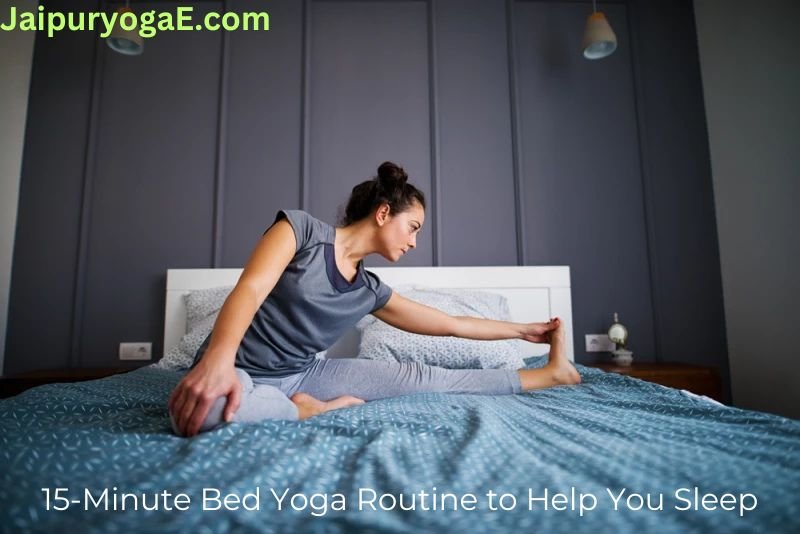Have you been finding it hard to sleep lately? You’re not alone. Many people around the world, especially during the COVID-19 pandemic, have had trouble getting enough rest.
A survey asked 2,000 people in the U.S. about their sleep, and guess what? Almost 1 in 3 said they slept worse in 2020 than in 2019. On average, they got only 5.5 hours of sleep each night! That’s not enough for our bodies to feel healthy and strong.
But here’s some good news: gentle stretches or yoga can actually help you sleep better!
In a big survey by the U.S. Department of Health, over half of the people who did yoga said their sleep improved because of it.
Want to know how yoga works its magic for better sleep? It’s even more helpful when you do it as part of your bedtime routine. Keep reading to discover a few easy yoga poses you can try right in your bed!
The Benefits of Sleep Yoga
Doing yoga in the evenings improves your ability to fall and stay asleep. According to Niki Saccareccia, a yoga instructor who is concerned with relaxing and healing yoga, all worries shrink because it relaxes the body and clears the mind.
Yoga strengthens a specific region of your body known as the parasympathetic nervous system. This system is active when the body is in a more relaxed state, preparing you for sleep.
Saccareccia says, “When we focus on ‘resting’ instead of ‘doing,’ we are sending signals to our nervous system that it is time to relax.” Gentle yoga such as Yin yoga includes slow stretching, long-held positions, and deep breathing to assist transfer the brain into calmer waves similar to those experienced in bed.
The Best Bedtime Yoga Poses for Better Sleep
Ready to add yoga to your bedtime routine? Try this six-pose sequence from Niki Saccareccia! It’s great for everyone, whether you’re a beginner or already know some yoga. You can do it quickly or take your time for a longer, relaxing session.
Start about two hours before bedtime. Turn down the lights, set your phone to airplane mode (or turn off sounds and notifications), and put away anything that might distract you. Then get comfy on your bed or grab a yoga mat and sit on the floor. You can do these poses in either spot.
Seated wide-legged forward fold
Start by sitting on the side of your bed or a chair with your legs wide and your feet flat on the floor. Slowly lean forward until your head and upper body rest gently between your legs. Stay in this position and take four deep, calming breaths.
If you’re using a yoga mat, you can do this pose while standing. Just bend your knees a lot and fold forward, letting your body relax.
Seated forward fold
Sit in the middle of your bed or on a yoga mat with your legs stretched out in front of you. Slowly lean forward, letting your upper body rest over your legs. If this feels uncomfortable, you can put a pillow under your forehead or knees for support. Take four deep breaths, letting your body relax in this position.
Child’s pose
Start on your hands and knees on your bed or yoga mat. Slowly push back until your arms are stretched out in front of you and your bottom rests over your heels. Let the tops of your toes press gently into the bed or mat. Relax your body, letting it feel heavy and calm.
If you want extra comfort, place a pillow under your forehead and chest so your belly rests on it. Stay here and take four deep, slow breaths.
Seated or reclined cobbler’s pose
Sit up tall and bring the bottoms of your feet together so your legs make a diamond shape. Let your knees drop outward. If it feels uncomfortable, you can put a pillow under each knee for extra support.
Slowly lean forward, letting your upper body rest over your legs. Take four deep, calming breaths while staying in this position.
Legs up the wall
Lie on your back and face your headboard (or a wall if you’re on the floor). Scoot your bottom as close to the headboard or wall as possible. Stretch your legs straight up, resting them against the headboard or wall. Let your feet relax and fall to the sides comfortably.
Stay in this position for as long as you like, but aim for five to ten minutes if you can.
Corpse pose
Lie down on your back and gently close your eyes. Relax your neck and shoulders. Wiggle your feet a little, then let them rest. Let your arms and hands fall to your sides and relax completely.
Soften your jaw and let your tongue feel loose. When you’ve finished any small movements to get comfy, stay still and calm. Take four deep, slow breaths, letting your whole body relax.
More Bedtime Wind-Down Tips
Yoga is a great way to prepare for sleep, however, it isn’t the only activity that can be performed in conjunction with the other parts of your bedtime routine. Yoga is great for sleep.
Apart from yoga, says Niki Saccareccia , other good activities include warm baths like spraying essential lavender oils on pillow cases, physical training or even naps. Or maybe you’ve kept a diary telling of your day and would like to read it; or perhaps you are in the mood for guided meditations.
The crucial takeaway is: all activities done must be of a non-screen nature including maturity games that aid arousal. Blue light inhibits melatonin production henceprotein reducing your body’s ability to sleep.
But, once done, the most critical thing is to do these things frequently. Proper sleeping habits allow your getting sleep and waking up processes to be automated.
“Getting yourself ready to sleep is a fun process,” informs Saccareccia. “Night time preparations are important and should be regarded with the utmost seriousness.”
